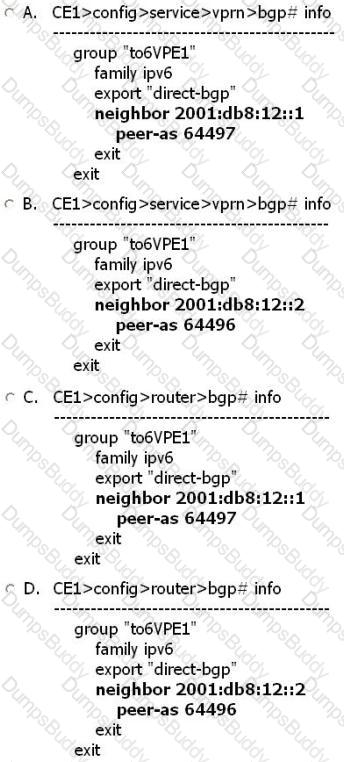Click on the exhibit.
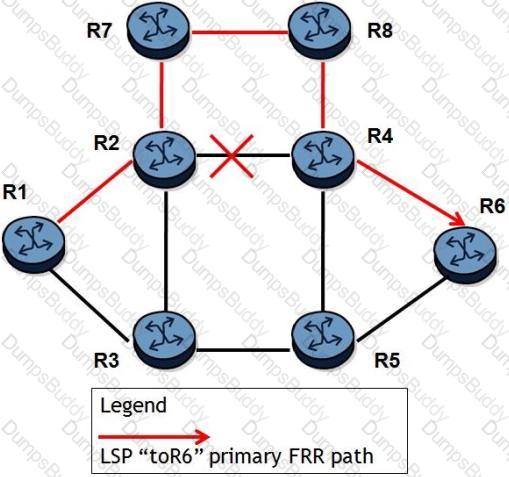
A fully loose LSP MtoR6" is enabled with FRR protection. All links have the same cost. After the link between R2 and R4 goes down, FRR protection repairs the LSP and traffic traverses on R1-R2-R7-R8-R4-R6. By default, which of the following about this LSP on an Alcatel-Lucent 7750 SR is FALSE?
Which of the following statements best describes the flooding of traffic on a PE when traffic is received on a spoke SDP?
Two directly connected routers set different interface Hello timeout values. Router R1 uses 15 seconds, while router R2 uses 30 seconds. Which of the following best describes the LDP adjacency?
Which of the following SAPs will forward all tagged and untagged frames on the port? (Choose 2)
Click on the exhibit button below.

Assuming the customer only needs to monitor traffic from PE3 to the customer site, what three items are missing from PE3's configuration? (Assume that the IP/MPLS network structure between the local and remote PEsis in place.)
Click on the exhibit.
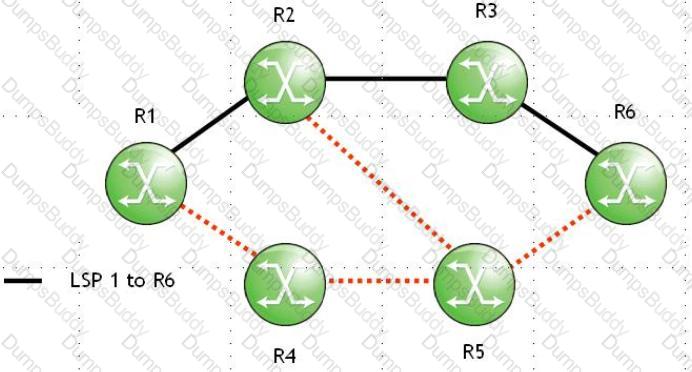
When router R1 forwards a PATH message to router R2, which of the following about the PATH message's IP header is TRUE?
Which of the following SAPs will forward tagged frames with an outer VLAN tag of 200? (Choose 3)
Which of the following statements regarding OSPF routing updates on a multi-access network segment is true?
Click the exhibit button.
Which of the following statements best describes the format of data traffic sent from the PC to the server?
Click the exhibit button.
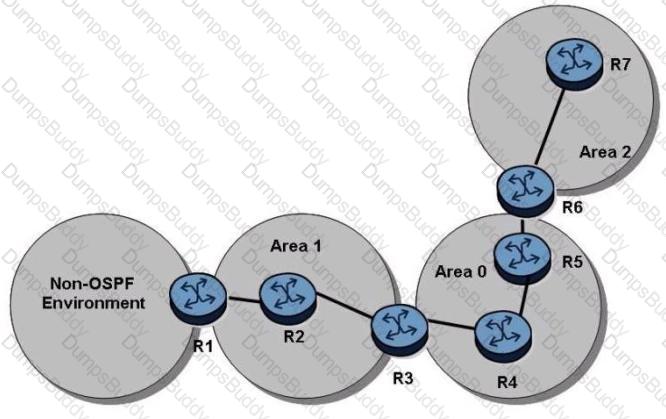
In the topology shown, router R1 is an ASBR configured to export external routes to OSPF. Assuming that there are no stub networks, which of the following statements regarding Type 4 LSA generation is true?
What command will show the OSPF neighbors, and their status on the Alcatel-Lucent 7750 SR?
Why must the MTU be changed when configuring an IES spoke termination to a VPLS?
A VPRN service is configured with BGP used as the CE-PE routing protocol. What address families are required on the PE-CE BGP session?
Which service type would be used to provide a bi-directional Layer 2 connection of TDM circuits over an IP/MPLS network?
How many service labels must be signaled to bring up a fully-meshed VPLS among five PE routers?
Consider an E-pipe service configured with SAP 1/1/1:5 and SAP 1/1/1:6. If the SAP 1/1/1:5 accepts an ingress frame, which of the following is TRUE?
A network consists of 4 PE routers. A customer requires a VPLS service and has sites connected to each PE. Each site must have direct connectivity with all other sites. How many SDPs must be configured on each PE?
Click on the exhibit.
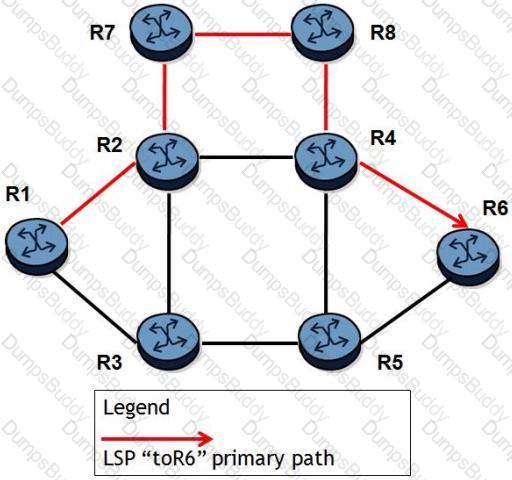
A fully loose LSP "toR6" is configured. All links have the same cost and all routers are Alcatel-Lucent 7750 SRs. The LSP currently traverses the path R1-R2-R7-R8-R4-R6 and the resignal timer is enabled. Which of the following about this LSP is FALSE?
Which of the following represents a SAP on a physical port configured with Q-in-Q encapsulation?
Which of the following about RSVP-TE LSP configuration in a Alcatel-Lucent 7750 SR is TRUE?
When a router receives an IP packet, but does not find a match in the routing table for the destination IP address, what actions are performed by the router?
Which of the following are types of routers in an IS-IS topology? Choose three answers
Which of the statements below best describes the operation of the IPv6 anycast address?
What is the value of the protocol discriminator used to denote IS-IS protocol information?
Which of the following best describes how IS-IS routers exchange updates on an Ethernet interface?
How many bytes make up the system ID in an IS-IS NSAP address on the Alcatel-Lucent 7750 SR?
In which of the following types of areas does an OSPF router not set the E bit in its Type 1 LSA?
A static route is created using the command "static-route 2.3.4.0/24 next-hop 1.2.3.4". What is the correct traceroute command to test this static route on an Alcatel-Lucent 7750 SR?
From the list below select the statements that describe the behavior of link state information aging. (Choose 2)
Click the exhibit button.

What is the command to configure a static route on the Alcatel-Lucent 7750 SR router R1 to reach the network behind router R2?
Which of the following statements regarding IS-IS Hello packets are true? Choose two answers.
On which component is vc-type configured to create an E-pipe service that preserves the VLAN tag during transport?
Which of the following conditions will prevent an OSPF adjacency from reaching the full state? Choose three answers.
If a Router originates a type 1 router LSA with the E bit set what types of areas can it belong to? Select all that apply.
In an OSPF environment, what must a router receive after it sends out an update?
Exhibit

Given the two configurations shown, identify the two incorrect statements below: (Choose two)
Click the exhibit button.

In the topology shown, router R1 is an ASBR configured to export external routes to OSPF. How many type 4 LSAs will be present in the network?
Click the exhibit button. Assuming point-to-point links, which of the following statements is true?

A service needs to accept frames that have the following: an outer VLAN tag of 200 with an inner VLAN tag of 33; and frames that have an outer VLAN tag of 250 with an inner VLAN tag of 33. What SAP(s) need to be configured?
By default, what happens when a packet with a VLAN tag is received on a SAP provisioned with null encapsulation?
Which of the following about route distinguishes on the Alcatel-Lucent 7750 SR is FALSE?
All services mapped to an SDP use the same transport encapsulation type (either GRE or MPLS)
Customer 'A' has sites on 3 different Alcatel-Lucent PE routers. The routers are connected to each other through an IP/MPLS network in a full mesh fashion. Customer 'A' requires a VPLS service. Which of the following statements are TRUE? (Choose2)
On Alcatel-Lucent 7750 SR OS, routing information between the CE and PE can be exchanged using the following methods.
Click on the exhibit.

Router R2 advertises an OSPF summary route 10.10.10.0/24 into Area 1. Router R3 receives labels for individual FECs 10.10.10.2/32 and 10.10.10.4/32. These two FECs are installed in router R3's LIB but not in the LFIB. What needs to be done on router R3 to install these labels into its LFIB?
Click on the exhibit.
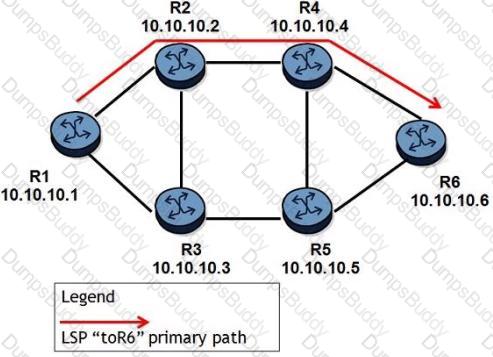
An LSP path is established on router R1 toward router R6. If there is a problem on router R4, but the link between R2 and R4 remains up, which of the following will affect the failure detection time?
On the Alcatel-Lucent 7750 SR, which one of the following steps is NOT required when enabling an MP-BGP session between PE routers in a VPRN?
Which approach to LSP path diversity provides the most control, but the least flexibility?
Which type of LSA packets describe external routes originated within an NSSA area, and to what type are they converted to at the ABR?
Click on the exhibit.

A static route has been configured on router R1 to reach the PC at 139.120.121.2. What else is required to make the ping succeed?
Click on the exhibit.

The link between routers R4 and R6 are configured with an admin group "red". What happens when the LSP is first signaled?
Fill in the blanks: The device at the beginning of an LSP is referred to as the_________, and the device at the end of an LSP is referred to as the ___________.
An LSP path is configured as follows:
- Shared-explicit reservation style
- Make-before-break (MBB) enabled
- 500Mpbs bandwidth reserved on a 1Gbps link
With 100Mbps of unreserved bandwidth remaining, the operator increases the LSP-path's bandwidth reservation to 900Mbps. What happens to the existing LSP?
Router R3 signals an LSP, reserving 1Gbps bandwidth on a 10Gbps link. RSVP configuration limits reservable bandwidth to 20 percent on the egress interface. Which of the following statements is true?
Click on the exhibit.

OSPF is operational on all links in the network diagram, all links have the same cost and all routers are configured with an ECMP value of 4. Router R4 advertises the prefix 192.168.3.0/24 into OSPF.
How many entries for prefix 192.168.3.0/24 will be l n router R1's routing table?
Click on the exhibit.
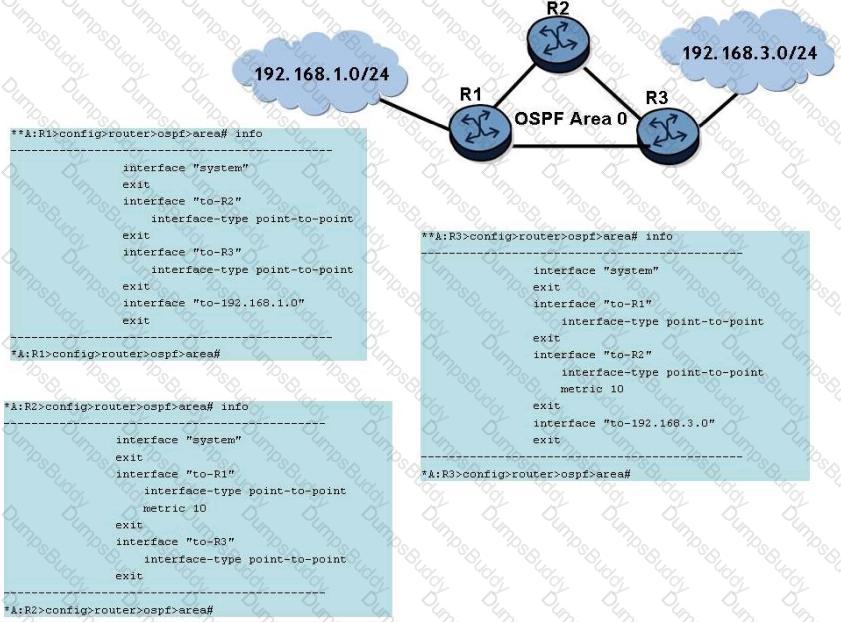
All ports in the network are operationally up and have a speed of 1Gbps.
Which of the following is TRUE?
Click on the exhibit.

What triggers convergence of the routing protocol when the link between switch 1 and switch 2 goes down?
Which of the following routing protocols are supported on the Alcatel-Lucent 7750 SR to enable constraint-based LSPs? (Choose two)
Which of the following configurations allow a router to periodically attempt to move LSP traffic to a better path, if the head end can find one?
Which of the following statements best describes downstream unsolicited label distribution?
Click on the exhibit.
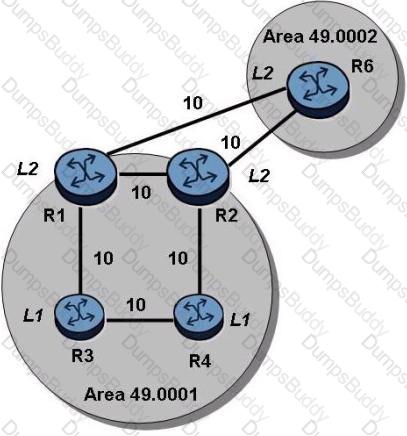
Examine the physical topology of the IS-IS network, the metrics of the links and the levels of the routers. All routers have a system address included in IS-IS.
Which of the following describes the route that router R4 will use to reach the system address of router R6?
Click on the exhibit.
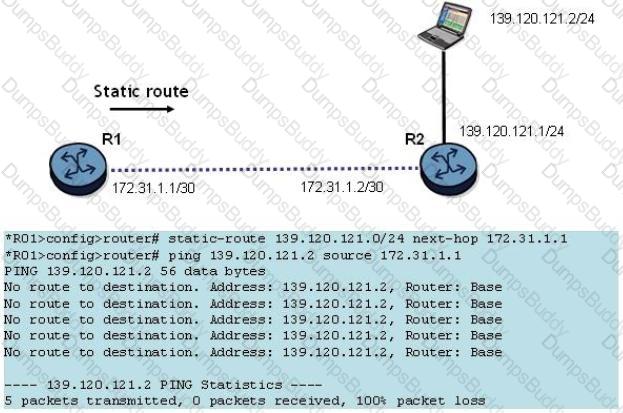
A static route has been configured on router R1 to reach the PC at 139.120.121.2. What might be causing the ping to fail?
Which of the following message types does RSVP use to set up an LSP? (Choose two)
Click on the exhibit button below. Assume the following:

- Each router's OSPF interfaces are in the areas shown.
- Bidirectional LDP-over-RSVP tunnels extend from routers R1 to R3 and back over the path R1-R4-R5-R3.
- You enable fast reroute facility bypass on the R5-R3 RSVP LSP.
- Router R5 acts as a PLR, protecting the R5-R3 link by building a bypass tunnel through router R2.
You build a layer 2 VPN on routers R1 and R3, using the LDP-over-RSVP tunnels. What MPLS configuration step must you complete on router R2 for it to protect the end-to-end service?
Which of the following statements regarding RSVP refresh reduction are true1? (Choose two)
Click on the exhibit.

Given the output shown, which router is the ASBR in this network?
Click on the exhibit.

The OSPF adjacency between routers R1 and R3 does not come up.
Which of the following is a possible solution to the problem?
Click on the exhibit.
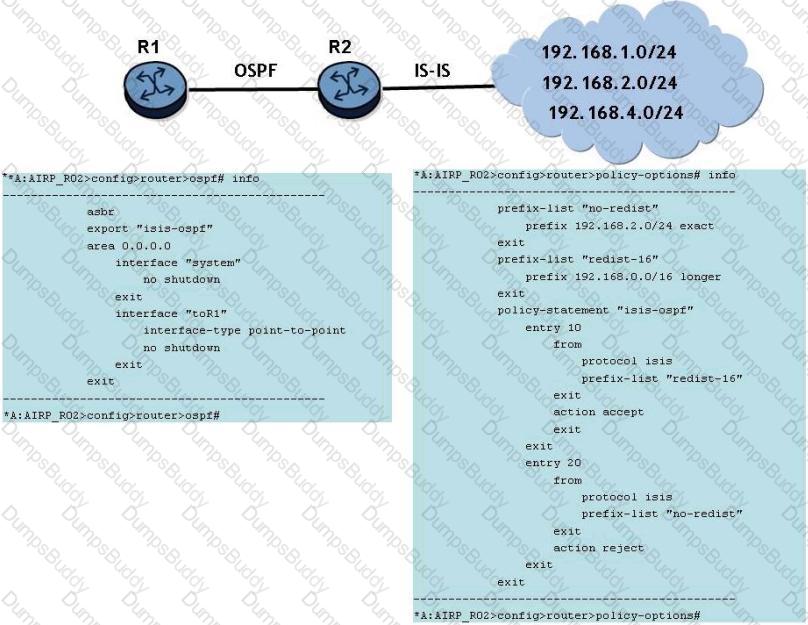
Router R2 learns the networks shown from IS-IS. Router R2 is configured to redistribute routes from IS-IS to OSPF as shown. Assume the OSPF and IS-IS adjacencies are operational.
How many OSPF Type 5 LSAs will router R1 receive from router R2?
Which of the following is a characteristic of OSPFv2 that was NOT preserved in OSPFv3?
Which of the following statements regarding RSVP path messages on an Alcatel-Lucent SR is true?
Click the exhibit.

Which of the following statements about the E-pipe service is TRUE?
Which of the following about the components of a distributed service on the Alcatel-Lucent 7750 SR is TRUE?
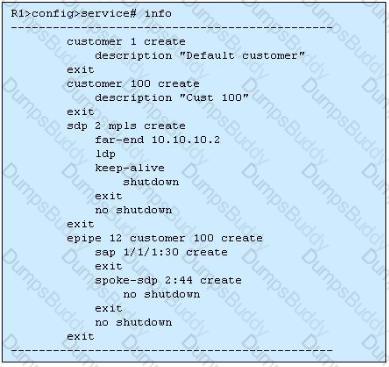
Click the exhibit.

E-pipe 100 is using an SDP (4) with an LSP that uses the path shown (PE1-PE2-PE3-PE4). Which of the following is the expected output from the OAM command?
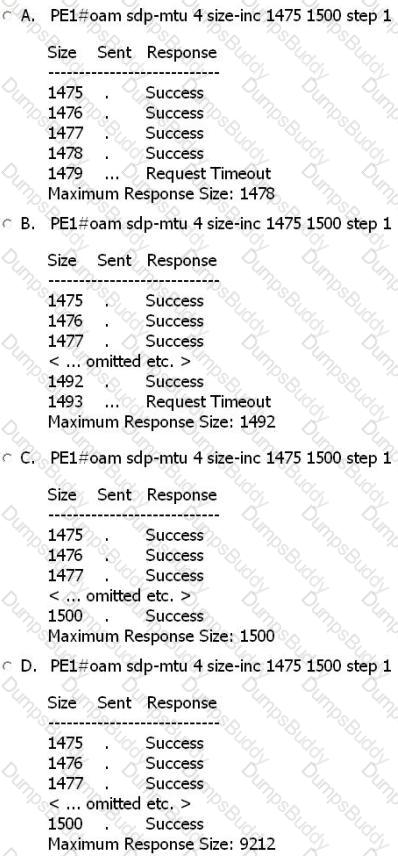
A network technician needs to set up a local mirror to replicate traffic for examination with a protocol analyzer. The analyzer is on port 1/1/4 of his service router. Which of the following configuration steps is required?
What is the best approach of making MTUs match between a VPLS and a spoke IES in order to bring up the service?
Click the exhibit.

Routes are exchanged between CE1 and PE1 using BGP. CE2 and PE2 use static routes to forward traffic to and from the VPRN. Which of the following is FALSE?
On an Alcatel-Lucent 7750 SR, which vc-type will forward service delimiting tags at the ingress PE?
Click the exhibit.

The output is from PE router R4 about VPRN service 100. How many prefixes have been learned from the MP-BGP protocol?
Once a service has been created with a customer association, it is possible to change the customer association.
Click the exhibit button.
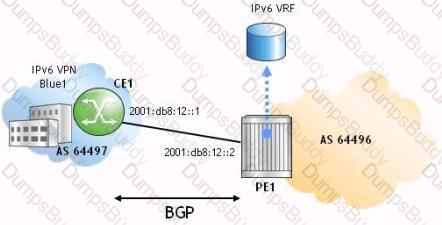
Part of a 6VPE deployment is shown. Which of the following is the correct configuration and context on router CE1 for a BGP peering session with 6VPE1?
